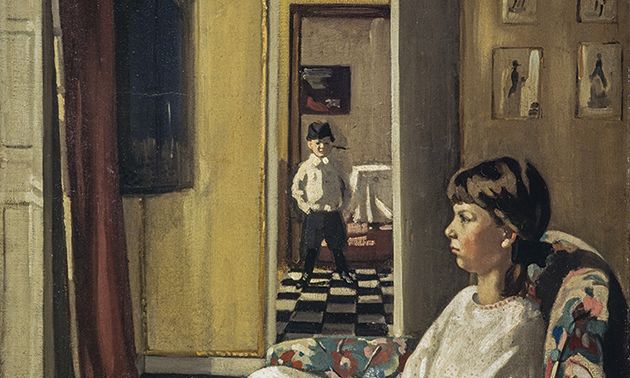The Grange (around 1911) shows the artist’s children Kit and Nancy in their Sussex home
Photo: Antonia Reeve, © Scottish National Gallery
The reputation of Mabel Nicholson (1871-1918) has long been eclipsed by that of the male artists in her family: her brother, James Pryde; her husband, William Nicholson; and her eldest son Ben Nicholson. “They—Ben and William especially—are giants in British art, but Mabel’s contribution was written out along the way, effectively reduced to a footnote in their stories,” says Lucy Davies, the author of a new book on the artist and co-curator of the exhibition Prydie: The Life and Art of Mabel Pryde Nicholson at The Grange Gallery in Rottingdean, near Brighton, East Sussex. “I wanted to find out who she really was and extricate her from their shadow; to give her centre stage for once rather than the bit part she is always allotted.”
The exhibition will be the first in over a century devoted to Mabel’s art and takes place at the house on the Sussex coast where she and her family lived from 1909 to 1914, and where she had a studio designed specifically for her by Edwin Lutyens. She and her husband met as students in the 1880s at the Hertfordshire art school run by Hubert von Herkomer but it was only after the birth of their four children and their move to the village of Rottingdean that Mabel resumed painting, finding almost immediate success with dealers and collectors. The focus of her art was her own family and friends, and above all the characteristically Edwardian subject of unposed figures in interiors. Influences, from Johannes Vermeer to Vilhelm Hammershøi, can easily be discerned, especially in Nicholson’s stage-like settings; but her work is lifted above the commonplace by some strikingly imaginative, and enigmatic, compositions and a quiet but pervasive air of foreboding. As Davies notes, “There’s always this element of mystery or psychology in her pictures. And her portraits can be really wonderful, especially of her children. They’re sort of layered with her memories and emotions, as if she left a bit of herself and her relationships with them behind in the paint.”
Several of Nicholson’s more significant paintings are untraced, but the exhibition gathers together some 30 works from public and private collections alongside photographs, letters and other ephemera to tell the story of her late-flowering but tragically brief career: she died, aged 47, in the so-called Spanish flu epidemic of 1918.
The concurrence of this exhibition with Tate Britain’s sweeping survey of female British artists (Now You See Us: Women Artists in Britain 1520-1920, until 13 October) means that she is, unfortunately, absent from it. But her rediscovery is part of a wider reassessment being undertaken of those women who were such an integral part of the British art scene at the beginning of the 20th century, among whom Mabel Nicholson can be counted one of the most accomplished.
• Prydie: The Art and Life of Mabel Pryde Nicholson, The Grange Gallery, Rottingdean, Brighton, 20 July-26 August

